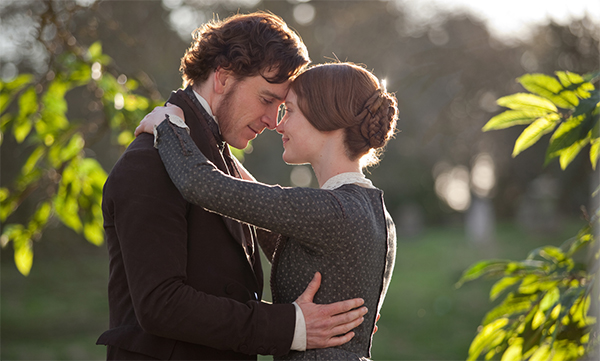
When I first saw the trailer for the new “Jane Eyre” film, I was hopeful. With the ominous clouds rising on the moors, the eerie score and stone-cold-fox director Cary Fukunaga at the helm, the mystery of the novel was shining through, selling the film as so much more than a period romance. Maybe this film would bring Charlotte Brönte’s novel to the screen without shaming it.
With Michael Fassbender (“Inglorious Basterds”) and Mia Wasikowska (“Alice in Wonderland”) taking the lead roles of Mr. Rochester and Jane respectively, I wasn’t sure what to expect. Fassbender looked far too pretty for the role with his leading man’s jaw and Wasikowska seemed almost too boring to hold my imagination.
The most notable thing about the script, written by Moira Buffini, is that the story is told almost entirely through flashbacks. We meet Jane as she’s running away from Thornfield in hysterics and we don’t get much of her story until she explains herself to the Rivers family, headed by a surprisingly endearing Jamie Bell as St. John, who welcomes her into their home. From that point on we’re introduced to the heroine’s tale of woe; her abusive aunt, her strict and humbling education and her tragic first friendship are all shuffled onto the screen and eased out in a short time. The story is less of a Bildungsroman and more of a Gothic mystery in this adaptation.
The narrative gave the most attention to Jane’s time working under Mr. Rochester, which is understandable given that the meat of the story and the mystery takes place there. While it seemed to skimp on the detail in other parts, this section of the movie is where it hit its stride.
Understanding that if it ain’t broken you shouldn’t fix it, most of the film maintains Brönte’s beautiful prose. Buffini’s decision making should be applauded here. The prose in “Jane Eyre” is some of the most beautiful writing out there and to see it brought to the screen without being bastardized by a narcissistic script-writer is a thrill in itself.
On the same note, it was great to see the film’s funny-bone kept intact. Because, yes, on top of the mystery and romance and angst, “Jane Eyre” is actually funny.
When Rochester’s ward, Adele, sings an awkwardly adult song in her childhood falsetto, complete with ignorantly seductive hand gestures, Dame Judi Dench’s delightful Fairfax notes how very French the little jailbait’s routine was. The Dame managed to steal every scene her supporting character was in, playing a more maternal Fairfax; not exactly the way Brönte wrote the character, but she was as impressive and endearing as ever.
Speaking of the funny scenes, I wonder, who do I have to hunt down and threaten in the film industry to see Mr. Rochester in drag?
In the novel there’s this wonderfully hysterical, wonderfully Brönte scene where the enigmatic Mr. Rochester is nowhere to be found and his guests are being entertained by a mysterious gypsy woman who refuses to leave until she sees every young lady in the house. If you retrieve your mind from the gutter and remember we’re talking about a period piece, you may recall that Rochester is the one dressed as the gypsy scaring the young women with his fortune telling.
In the 2006 BBC adaptation, this scene is included but eviscerated by the gypsy role being played by a woman hired by Rochester rather than by Toby Stephens. So yet again, my heart was broken when this adaptation failed to take advantage of and share this bonding moment between the two protagonists.
Understanding that a 700-page novel is bound to be trimmed down when transferred to the screen, most of the right scenes were chosen excluding a few notable moments. They weren’t going to be able to add every bit of touching dialogue, every chuckle-worthy vignette or heartbreaking trauma; but they could’ve made me feel a little more for the scenes they did include.
When little Jane was pulled away from her dead friend’s bed, a scene that I should’ve been bawling during, I found myself wondering why I should care. Based on the film, Jane had spent a few close moments chatting with Helen, the little red-headed girl who’d given her bread when she was being punished. There was no real evidence of their friendship, which I’m sure left those who weren’t familiar with the novel confused. Like too much of this film, the motions and the scenes were built and almost executed, but still left me slightly unsure of what I should be feeling

